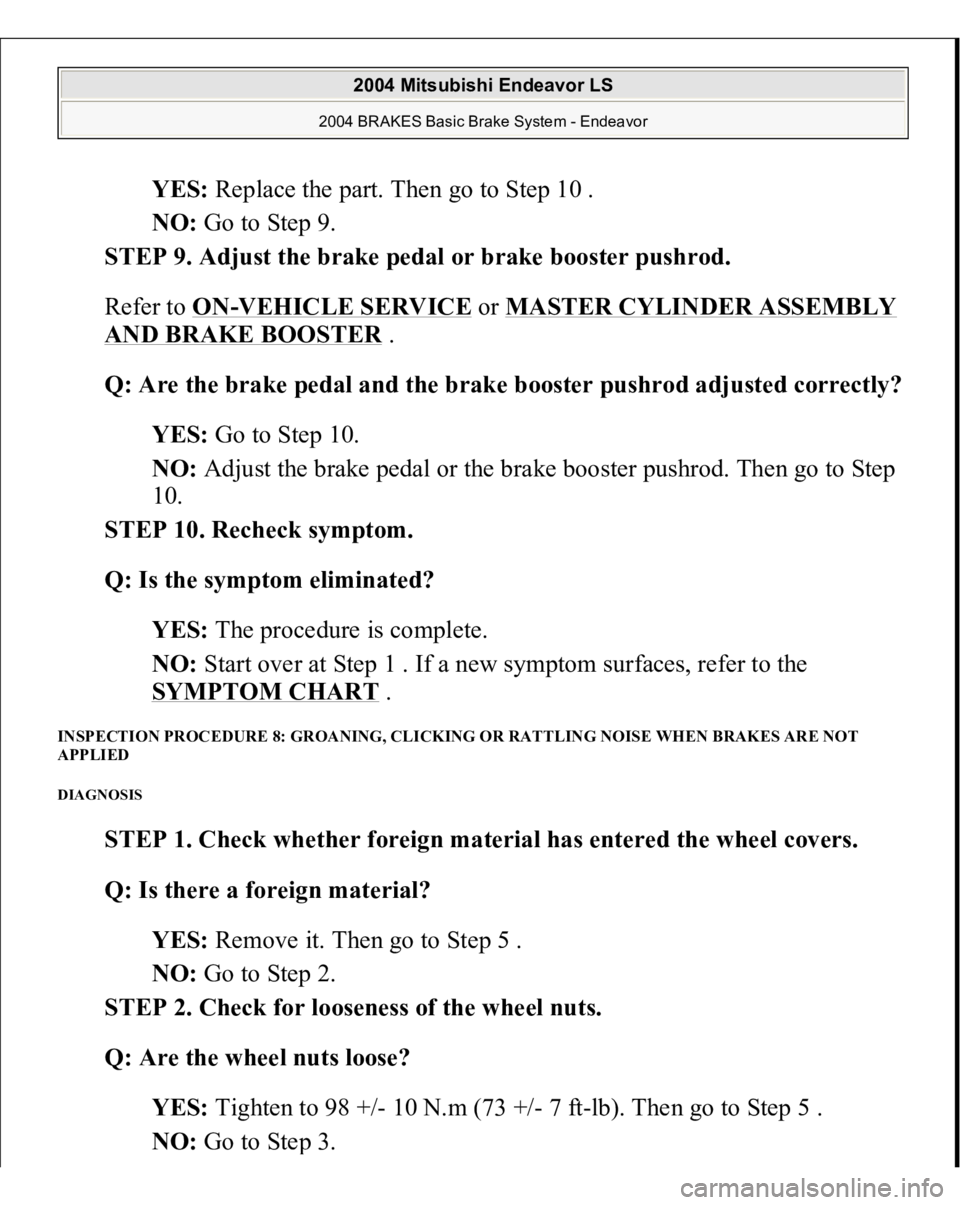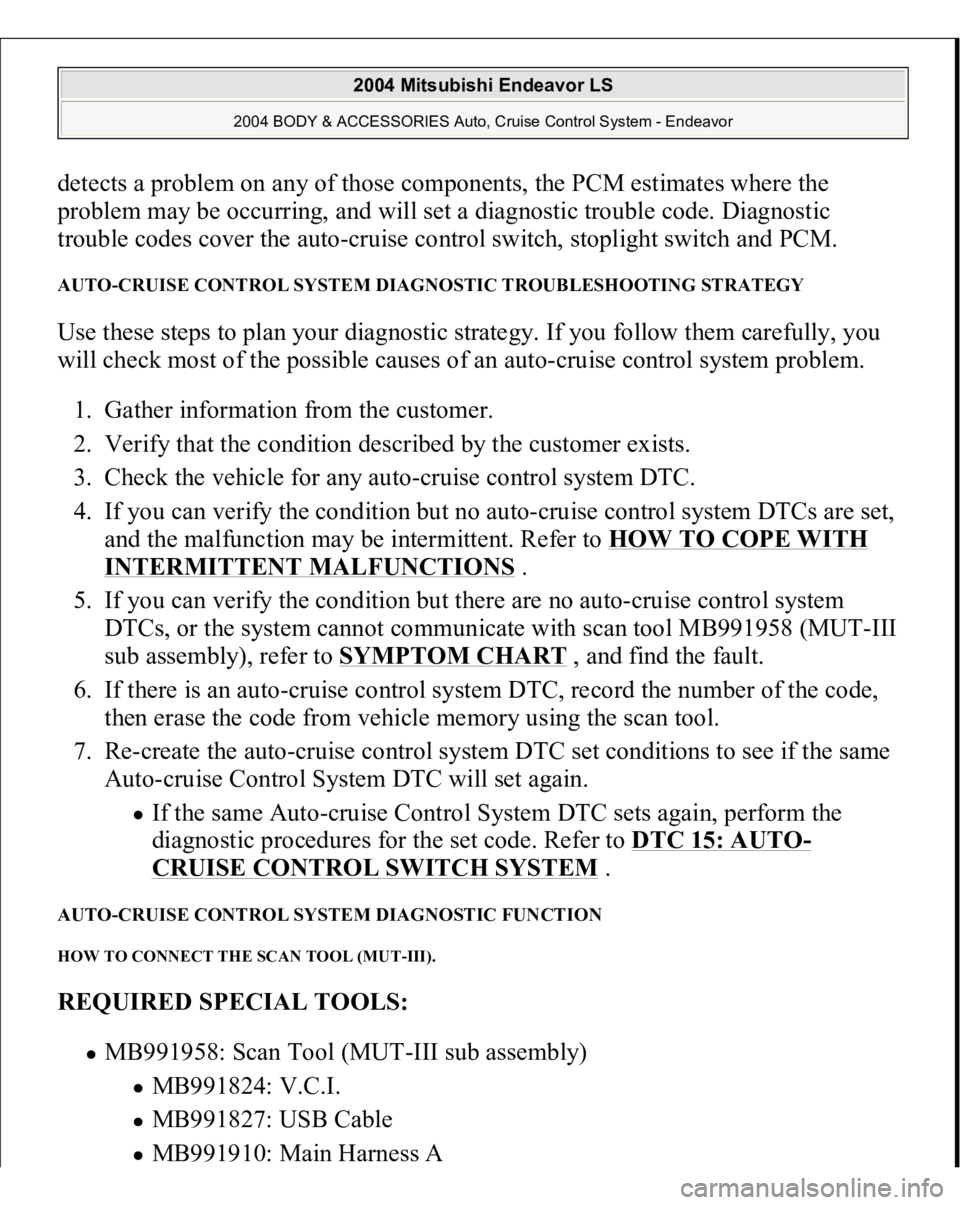Page 720 of 3870

YES: Replace the part. Then go to Step 10 .
NO: Go to Step 9.
STEP 9. Adjust the brake pedal or brake booster pushrod.
Refer to ON
-VEHICLE SERVICE
or MASTER CYLINDER ASSEMBLY
AND BRAKE BOOSTER
.
Q: Are the brake pedal and the brake booster pushrod adjusted correctly?
YES: Go to Step 10.
NO: Adjust the brake pedal or the brake booster pushrod. Then go to Step
10.
STEP 10. Recheck symptom.
Q: Is the symptom eliminated?
YES: The procedure is complete.
NO: Start over at Step 1 . If a new symptom surfaces, refer to the
SYMPTOM CHART .
INSPECTION PROCEDURE 8: GROANING, CLICKING OR RATTLING NOISE WHEN BRAKES ARE NOT
APPLIED DIAGNOSIS
STEP 1. Check whether foreign material has entered the wheel covers.
Q: Is there a foreign material?
YES: Remove it. Then go to Step 5 .
NO: Go to Step 2.
STEP 2. Check for looseness of the wheel nuts.
Q: Are the wheel nuts loose?
YES: Tighten to 98 +/- 10 N.m (73 +/- 7 ft-lb). Then go to Step 5 .
NO: Go to Ste
p 3.
2004 Mitsubishi Endeavor LS
2004 BRAKES Basic Brake System - Endeavor
Page 741 of 3870
The master cylinder used has no check valve, so if bleeding is carried out by the
following procedure, bleeding of air from the brake pipeline will become easier.
(When brake fluid is not contained in the master cylinder).
1. Fill the reserve tank with brake fluid.
2. Keep the brake pedal depressed.
3. Have another person cover the master cylinder outlet with a finger.
Fig. 26: Identifying Master Cylinder Outlet
Courtesy of MITSUBISHI MOTOR SALES OF AMERICA.
2004 Mitsubishi Endeavor LS
2004 BRAKES Basic Brake System - Endeavor
Page 814 of 3870

detects a problem on any of those components, the PCM estimates where the
problem may be occurring, and will set a diagnostic trouble code. Diagnostic
trouble codes cover the auto-cruise control switch, stoplight switch and PCM. AUTO-CRUISE CONTROL SYSTEM DIAGNOSTIC TROUBLESHOOTING STRATEGY Use these steps to plan your diagnostic strategy. If you follow them carefully, you
will check most of the possible causes of an auto-cruise control system problem.
1. Gather information from the customer.
2. Verify that the condition described by the customer exists.
3. Check the vehicle for any auto-cruise control system DTC.
4. If you can verify the condition but no auto-cruise control system DTCs are set,
and the malfunction may be intermittent. Refer to HOW TO COPE WITH
INTERMITTENT MALFUNCTIONS
.
5. If you can verify the condition but there are no auto-cruise control system
DTCs, or the system cannot communicate with scan tool MB991958 (MUT-III
sub assembly), refer to SYMPTOM CHART
, and find the fault.
6. If there is an auto-cruise control system DTC, record the number of the code,
then erase the code from vehicle memory using the scan tool.
7. Re-create the auto-cruise control system DTC set conditions to see if the same
Auto-cruise Control System DTC will set again.
If the same Auto-cruise Control System DTC sets again, perform the
diagnostic procedures for the set code. Refer to DTC 15: AUTO
-
CRUISE CONTROL SWITCH SYSTEM
.
AUTO-CRUISE CONTROL SYSTEM DIAGNOSTIC FUNCTION HOW TO CONNECT THE SCAN TOOL (MUT-III). REQUIRED SPECIAL TOOLS:
MB991958: Scan Tool (MUT-III sub assembly)
MB991824: V.C.I. MB991827: USB Cable MB991910: Main Harness A
2004 Mitsubishi Endeavor LS
2004 BODY & ACCESSORIES Auto, Cruise Control System - Endeavor
Page 1001 of 3870
Fig. 1: Attaching Cloth Tape Panel Seams, Projections, Molding Seams And Glass And Body Seams
Courtesy of MITSUBISHI MOTOR SALES OF AMERICA.
2. Then make a road test to check that the places not covered by tape are not
sources of wind noise.
3. Remove the strips of tape one by one, making a road test after each is removed,
until a wind noise source is discovered.
2004 Mitsubishi Endeavor LS
2004 BODY & ACCESSORIES Door - Endeavor
Page 1002 of 3870
Fig. 2: Removing Strips Of Tape
Courtesy of MITSUBISHI MOTOR SALES OF AMERICA.
4. When such a place is found, cover it again and repeat the procedure to check if
there are any other noise source.
5. If no others are found, the last remaining tape is the only source.
2004 Mitsubishi Endeavor LS
2004 BODY & ACCESSORIES Door - Endeavor
Page 1343 of 3870
1. Install special tool MD998769 and the crankshaft pulley washer, and then
tighten the crankshaft bolt.
2. Align the timing mark on the crankshaft sprocket with the timing mark on the
oil pump case, and then rotate the sprocket three teeth counterclockwise.
Fig. 24: Aligning The Timing Mark On Crankshaft Sprocket & Timing
Mark On Oil Pump Case
Courtesy of MITSUBISHI MOTOR SALES OF AMERICA.
3. Align the timing mark on the left bank camshaft sprocket with the timing mark
on the rocker cover.
4. Align the timing mark on the right bank camshaft sprocket with the timing
mark on the rocker cover.
2004 Mitsubishi Endeavor Limited 2004 ENGINE Engine Overhaul - Endeavor
Page 1344 of 3870
Fig. 25: Align The Timing Mark On The Right Bank Camshaft Sprocket With Timing Mark On Rocker Cover
Courtesy of MITSUBISHI MOTOR SALES OF AMERICA.
5. Align the timing mark on the crankshaft sprocket with the timing mark on the
oil pump case.
6. Install the timing belt on each sprocket and pulley in the following sequence.
Do not leave the belt slack between each sprocket and pulley.
1. Crankshaft sprocket
2. Idler pulley
3. Left bank camshaft sprocket
4. Water pump pulley
5. Right bank camshaft sprocket
6. Tensioner
pulle
y
2004 Mitsubishi Endeavor Limited 2004 ENGINE Engine Overhaul - Endeavor
Page 1385 of 3870
1. Prepare three containers and approximately 5 DM< SD >3< /SD > (30.5 quart)
of diesel fuel. Into each container, pour enough diesel fuel to completely cover
a lash adjuster when it is standing upright. Then, perform the following steps
with each lash adjuster.
Fig. 63: Cleaning Lash Adjuster
Courtesy of MITSUBISHI MOTOR SALES OF AMERICA.
2. Place the lash adjuster in container A and clean its outside surface.
adjusters.
NOTE: Use a nylon brush if deposits are hard to remove.
2004 Mitsubishi Endeavor Limited 2004 ENGINE Engine Overhaul - Endeavor